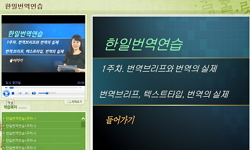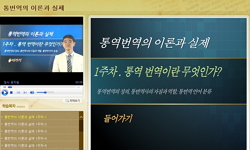One of the essential elements of English teaching for a long time was translation, and a number of entrance exams of universities or colleges focused on translation of paragraphs or texts for decades. Despite its significance, it has been a significan...
http://chineseinput.net/에서 pinyin(병음)방식으로 중국어를 변환할 수 있습니다.
변환된 중국어를 복사하여 사용하시면 됩니다.
- 中文 을 입력하시려면 zhongwen을 입력하시고 space를누르시면됩니다.
- 北京 을 입력하시려면 beijing을 입력하시고 space를 누르시면 됩니다.

A Study on the Performance Differences in Translating the Adjectives and Adverbs in the Same Form
한글로보기https://www.riss.kr/link?id=A106394562
- 저자
- 발행기관
- 학술지명
- 권호사항
-
발행연도
2019
-
작성언어
-
- 주제어
-
KDC
747
-
등재정보
KCI등재
-
자료형태
학술저널
-
수록면
1-18(18쪽)
- 제공처
-
0
상세조회 -
0
다운로드
부가정보
다국어 초록 (Multilingual Abstract)
One of the essential elements of English teaching for a long time was translation, and a number of entrance exams of universities or colleges focused on translation of paragraphs or texts for decades. Despite its significance, it has been a significant missing part to measure English proficiency in the classroom because it is not a format for high-stakes tests in Korea. This paper aimed at examining the performance differences in translating the words with the same form as adjective and adverb used in the paired sentences into Korean. More specifically, this study examined the awareness of the differing meanings of the same form of the words used as both adjective and adverb through translation. A total of 54 high school second years participated in the study. The findings of their qualitative analysis highlighted that the participants performed differently in translating the words in the paired sentences. One of the findings was that the students translated the words “fast” and “high” most correctly for both adjective and adverb, while their translating performance was extremely poor at the words “pretty” and “well” in the paired sentences as adjective and adverb.
목차 (Table of Contents)
- I. Introduction II. Literature Review III. Method IV. Results and Discussion V. Conclusion and Implications
- I. Introduction II. Literature Review III. Method IV. Results and Discussion V. Conclusion and Implications
동일학술지(권/호) 다른 논문
-
Revisiting Figurative Speech and Tandem-based Translation Courses: A Simile Case Study
- 한국통번역교육학회
- 조운익
- 2019
- KCI등재
-
- 한국통번역교육학회
- 김혜영
- 2019
- KCI등재
-
비즈니스 통번역의 특성 연구- 인하우스 통번역사를 대상으로 한 조사연구를 중심으로 -
- 한국통번역교육학회
- 안희연
- 2019
- KCI등재
-
- 한국통번역교육학회
- 신지선
- 2019
- KCI등재





 스콜라
스콜라






